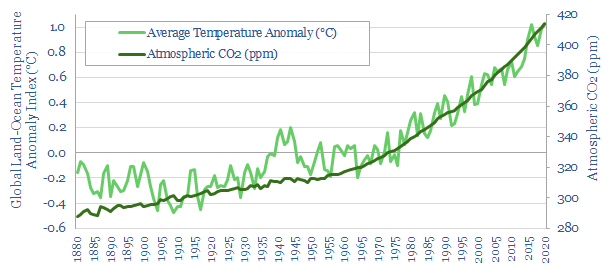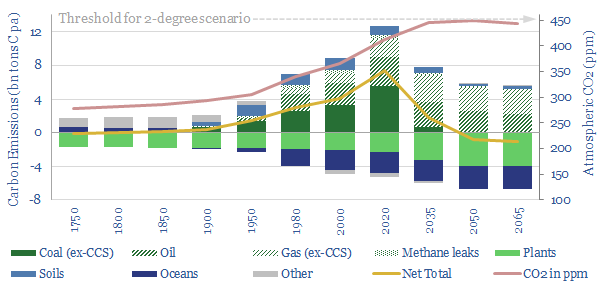This data-file is a simple global climate model. Specifically, it is a 30-line overview of the carbon cycle, from 1750-2065, covering the difference ‘sources’ and ‘sinks’ of carbon, and how carbon has moved between these reservoirs over time.
In 1750, for example, the atmosphere contained 280ppm of CO2, or in other words, 590 GT of carbon (in the form of CO2). At the same time, 840 GT of carbon was stored in the world’s plants, 2,600 GT was stored in the world’s soils, 10,000 GT was stored in fossil fuels, 38,000 GT was stored in the world’s oceans and an amazing 100,000 GT was stored in rocks (e.g., limestone, chalk… also known as ‘Europe’).
Over time, we think around 5% of the world’s fossil fuels have been removed from the sub-surface and combusted. While around one-third of the world’s primary forests and natural eco-systems have been degraded. In purely mathematical terms, therefore, the fossil fuel consumption and the destruction of nature are not dissimilar in impact. (Although in our own personal worldview, there is something ‘less bad’ about burning a forest that has already been dead for 300M years, than cutting down and burning a living one).
‘Net zero’ is achievable after 2050, with atmospheric CO2 remaining around 450ppm, under our ‘roadmap to net zero‘. This level is consistent with 2-2.5 degrees C of warming versus pre-industrial times, of which 1.2C has already occurred. And this result is derived in the data-file, including formulas quantifying the relationship between atmospheric CO2 and global temperatures.

An interesting nuance is that ongoing CO2 uptake in plants, soils and oceans may ‘buy a budget’ for hydrocarbons in a ‘net zero’ energy system. This is not a free pass to the fossil fuel industry to continue business as usual. But we do think there are routes to net zero that see continued use of oil and gas. Especially if the need for coal, oil and gas can be reduced through wind, solar, nuclear and efficiency improvements; high-carbon fossil fuels like coal are entirely switched to >50% lower carbon fossil fuels like gas; and a large portion of the remaining CO2 is captured or offset by restoring nature.
Please download this simple global climate model to stress-test your own assumptions. Notes from Academic papers follow in the ‘Sources’ tab, to explain the ocean, soil and plant fluxes in our model. Our data are drawn predominantly from the IPCC.
